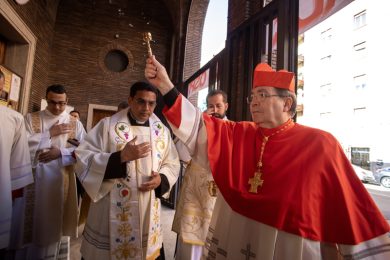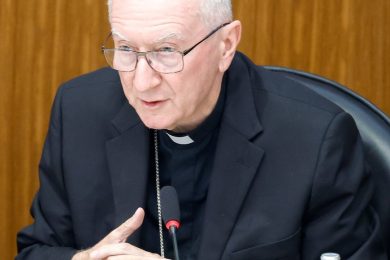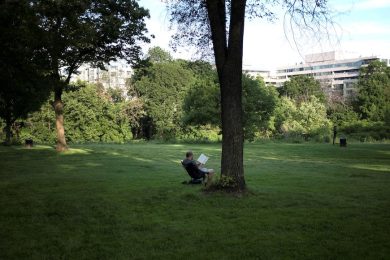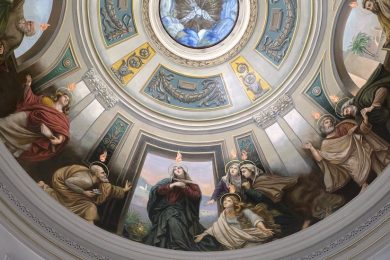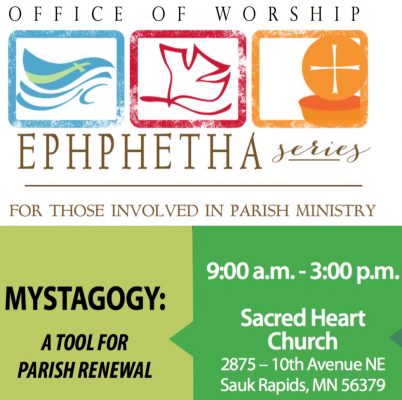
According to Timothy Johnston, director of the diocesan Office of Worship, the fervor that once surrounded the Rite of Christian Initiation of Adults has waned across the country.
In an effort to renew the excitement and engage not only pastors, parish ministers, musicians and catechists, but also all the faithful, Johnston wrote and received a grant from the Calvin Institute of Christian Worship in Grand Rapids, Michigan, to host a series of four presentations titled “Ephphetha” (meaning “be opened”) on the importance of RCIA.
“The goal of the series is to help communities engage in vital worship,” Johnston said. “RCIA in our tradition is a very particular and good way to help engage a parish community in evangelization. It has the potential, if implemented well and fully, to revitalize the worshiping life of the community.”

On May 13, the last seminar in the Ephphetha Series, “Mystagogy as a Tool for Parish Renewal,” will take place at Sacred Heart Church in Sauk Rapids (see box).
This final session is a presentation on mystagogy, a period of breaking open the rites of penance and Eucharist. Presenters for the course include Timothy O’Malley, director of the Notre Dame Center for Liturgy; and Father J. Michael Joncas, an internationally recognized priest, liturgical composer, author, speaker and associate professor at the University of St. Thomas in St. Paul, Minnesota.
The Visitor spoke with O’Malley and asked what the significance of the period of mystagogy is and why all baptized Catholics have a role in it. His answers are below.

Q: Could you explain the term ‘mystagogy’?
A: Mystagogy certainly means the period of formation that takes place during the Easter season. It’s learning to savor the sacramental life of the church, to delight in what God has accomplished through the son, Jesus. But, of course, mystagogy is not reducible to this. Rather, mystagogy is that deeper entrance into the mystery of salvation through liturgical signs. Mystagogy is in essence a spirituality of the liturgy for the Christian, who begins to see all of his or her life in light of salvation history.
Q: Typically, the period of mystagogy is understood as the 50 days of the Easter season. Is that accurate?
A: We definitely should expand the period of mystagogy beyond the 50 days of Easter. All liturgical preaching during the year should be mystagogical. All catechesis should be mystagogical insofar as it allows us to savor Christ dwelling among us. A couple’s marriage should be mystagogical, since all the joys and sorrows of family life should be understood according to the mystery of Christ celebrated in the liturgy. Mystagogy is learning to see how every dimension of human life is to be a liturgical offering —and that’s why it’s not helpful to keep it simply during the Easter season.
 Q: What is the role of the baptized Catholic during the mystagogical period?
Q: What is the role of the baptized Catholic during the mystagogical period?
A: Every baptized Catholic has a role of actually participating in the mystagogical process themselves. It should simply become part of our lives to see how all our joys, all our sorrows, everything is to be united to the mystery of Christ. In this sense, the neophytes will learn to think mystagogically not just because of a formal program but because they encounter a community of faith that thinks mystagogically.
Q: What is the primary message you plan to share with the people of St. Cloud?
A: I hope to show the people of St. Cloud that the entire liturgical year is ripe for mystagogy and that mystagogy is really nothing more — yet nothing less — than a living, liturgical spirituality that infuses the home, the workplace and our common lives in the parish.
Q: What excites you the most about this topic?
A: I fell in love with mystagogical catechesis as I read through the liturgical homilies of the patristic and medieval era. There’s such a living sense that the liturgy we celebrate isn’t just a series of interesting practices or obligations. But that it’s a real connection with salvation history. That the God who created us, gave the law, redeemed us in Christ, is still involved in our lives. That’s very good news indeed.




